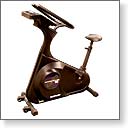| Exercise equipment |

Home aerobic exercise machines are available to meet any fitness level and can be used day or night. Before investing in any exercise machine, however, it is wise to test it out first at a gym, especially with supervised training to reduce the risk of injury. Read reviews of various brands in fitness magazines and on the Internet.
Very inexpensive exercise machines tend to be flimsy and hard to adjust, but many sturdy machines are available at moderate prices. The higher-end models may have computers to record calories burned, speed, and mileage. While their readouts may provide motivation and gauge the intensity of a workout, they are not always accurate. You might also consider buying a used machine, because it is common for people to buy a machine and then sell it when they realize they aren't getting much use from it. Of course, you can't return it if there's a problem.
Also, realize that there are very affordable ways to perform aerobic exercise. Shelling out money for an expensive machine may not have any impact on whether you actually exercise, although you might be tempted to think it will. A simple jump rope improves aerobic endurance for people who are able to perform high-impact exercise, and an aerobics stepping board and accompanying videotape will also give you a good workout. (Jumping rope should be done on surfaces that have some give to avoid joint injury. A good floor mat is important to provide cushioning for all home exercises.)
For burning calories, the treadmill has been ranked best, followed by stair climbers, rowing machines, cross-country ski machines, and stationary bicycles.
Elliptical trainers are also great for elevating your heart rate, burning calories, and increasing oxygen consumption, while lowering the likelihood of injury from high impact exercise.
Stationary bikes and stair climbers condition leg muscles. Stationary bikes are fairly economical and easy to use safely. The pedals should turn smoothly, the seat height should adjust easily, and the bike's computer should be able to adjust intensity. Stair machines offer very intense, low-impact workouts and may be as effective as running with less chance of injury. Rowing and cross-country ski machines exercise both the upper and lower body.
Strength-training equipment
Unlike aerobic exercise, strength training almost always requires some equipment. Strength-training equipment does not, however, have to cost much either. Dumbbells and resistance bands are inexpensive, portable, and effective.
Ankle weights strengthen and tone muscles in the lower body. (Such wearable weights should not be worn during high-impact aerobics or jumping.) Handgrips strengthen arms and are good for relieving tension.
A pull-up bar can be mounted in a doorway for chin-ups and pull-ups. More elaborate and expensive home equipment for working body muscles is also available.
Reviewed By: Jeffrey Heit, MD, Internist with special emphasis on preventive health, fitness and nutrition, Philadelphia VA Medical Center, Philadelphia, PA. Review provided by VeriMed Healthcare Network. Also reviewed by David Zieve, MD, MHA, Medical Director, A.D.A.M., Inc.
